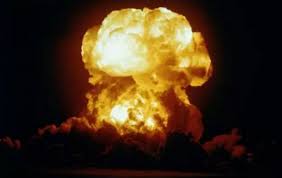
(Credit: en yibada.com)
If India and Pakistan fought a war detonating 100 nuclear warheads (around half of their combined arsenal), each equivalent to a 15-kiloton Hiroshima bomb, more than 21 million people will be directly killed, about half the world’s protective ozone layer would be destroyed, and a “nuclear winter” would cripple the monsoons and agriculture worldwide.
According to the 2007 study by researchers from Rutgers University, University of Colorado-Boulder and University of California, Los Angeles, all in the USA, the real costs would be higher and not just in India and Pakistan, where the first 21 million people – half the death toll of World War II – would perish within the first week from blast effects, burns and acute radiation.
Another two billion people worldwide would face risks of severe starvation due to the climatic effects of the nuclear-weapon use in the subcontinent, according to a 2013 assessment by the International Physicians for the Prevention of Nuclear War, a global federation of physicians.
Pakistan has an estimated 110 to 130 nuclear warheads as of 2015 – an increase from an estimated 90 to 110 warheads in 2011 – according to a report from the Bulletin of the Atomic Scientists, a global disarmament advocacy. India is estimated to have 110 to 120 nuclear warheads.
Pakistan’s nuclear weapons capability has previously deterred India from responding to previous attacks.
“At the end of the day, India has to ensure that the options it exercises–particularly the military ones – do not leave it worse off than before in terms of casualties and costs,” wrote analyst Manoj Joshi in The Wire.
It does not really matter if India has fewer nuclear weapons than Pakistan, IndiaSpend reported in April 2015, primarily because of the doctrine of “mutually assured destruction”, or MAD, as it is commonly known.
According to a report from the Bulletin of the Atomic Scientists, as many as 66 per cent of Pakistan’s nuclear warheads are mounted on 86 land-based ballistic missiles.
A major attack by Pakistan’s nuclear-tipped medium-range ballistic missiles (MRBMs) would likely target India’s four major metropolitan cities – New Delhi, Mumbai, Bengalore and Chennai (depending on where the missile is fired from), according to Sameer Patil, fellow, national security, ethnic conflict and terrorism at Gateway House, a think-tank in Mumbai.
The MRBMs would also target “the major commands of the Indian Army”, Patil told IndiaSpend.
Nearly half (40) of Pakistan’s ballistic missile warheads could be mated to Ghauri (named after 12th-century Afghan king Shahbuddin Ghauri, also known as Muhammad of Ghauri) MRBMs.
The missile has a claimed range of 1,300km and can target Delhi, Jaipur, Ahmedabad, Mumbai, Pune, Nagpur, Bhopal and Lucknow, according to a 2006 report on Pakistan’s ballistic missile programme by the National Institute of Advanced Studies (NIAS), Bengalore.
Pakistan has an estimated eight warheads which could be mated to the Shaheen (Falcon) II. This MRBM has a range of 2,500 km and can target most major Indian cities, including Kolkata on the east coast.
An estimated 16 warheads could be fired atop the short-range Ghaznavi (named after the 11th-century Afghan invader Mahmud Ghazni) ballistic missile. With a range of 270km to 350km, it can target Ludhiana, Ahmedabad and the outer perimeter of Delhi.
Pakistan has an estimated 16 nuclear-tipped Shaheen1 (falcon), short-range ballistic missiles (IRBM), having a 750km range which can reach Ludhiana, Delhi, Jaipur and Ahmedabad.
Pakistan has an estimated six 60-km range Nasr missiles, which could be mated to nuclear weapons. These tactical nuclear missiles could target “advancing battle formations of the Indian Army”, according to Patil.
Pakistan also has eight nuclear-tipped 350-km Babur cruise missiles with nuclear warheads.
An estimated 36 nuclear warheads, accounting for 28 per cent of Pakistan’s total, can be delivered using aircraft. US-made F-16 A/B aircraft can deliver 24 nuclear bombs while the French-made Mirage III/V can deliver 12.
India has deployed 56 Prithvi (earth) and Agni (fire) series of surface-to-surface ballistic missiles, which carry 53 per cent of India’s 106 estimated warheads, according to the Bulletin of Atomic Scientists.
This doesn’t take into account the estimated 12 warheads for the K-15 Sagarika submarine-launched ballistic missiles (SLBMs), which India has possibly produced for the nuclear-powered ballistic missile submarine INS Arihant.
Once commissioned, Arihant would give India a strategic nuclear triad and second strike capability, as this July 2015 IndiaSpend report notes.
“Given the smaller geographical size of Pakistan,” said Patil, India would likely target “Islamabad, Rawalpindi, Lahore and Karachi and the Pakistani Army Armed Corps headquarters at Nowshera”.
However, he cautioned: “The fallout of the nuclear attacks on Lahore and Karachi, for instance, would not just be restricted to the Pakistani territory, and depending on the wind directions, can affect both Indian and Afghan border territories.”
The 250 km-range Prithvi SRBM acts as a delivery system for 24 of India’s warheads. These are capable of hitting major Pakistani cities, such as Lahore, Sialkot, the capital Islamabad, and Rawalpindi, according to this May 2015 IndiaSpend analysis.
India has 20 nuclear-tipped Agni I SRBM and eight Agni II intermediate range ballistic missiles (IRBMs), with ranges of 700km and 2,000km, respectively. These are capable of covering almost all Pakistani cities, including Lahore, Islamabad, Rawalpindi, Multan, Peshawar, Karachi, Quetta and Gwadar.
Agni III, IV and V, with their longer ranges, might be able to reach all of Pakistan, but it can be safely said that they are directed more towards China.
India also possesses an estimated two ship-launched 350-km range Dhanush SRBM, which could be fitted with nuclear warheads.
India’s aircraft can deliver an estimated 45 per cent of 106 warheads. The Indian Air Force’s Jaguar fighter bombers can deliver about 16 nuclear warheads, while the French-built Mirage-2000 fleet can deliver 32.
Fears of a war between the two South Asian rivals erupted after a suspected militant attack on an army garrison in Uri Sector of Indian-held Kashmir claimed the lives of 18 Indian soldiers.
Tension between Pakistan and India has been high since an Indian crackdown on dissent in Kashmir following the killing by security forces of Burhan Wani, a young separatist leader, in July.
Both the South Asian rivals claim Kashmir in full, but govern separate parts, and have fought three wars since independence from Britain in 1947, two of them over Kashmir.
Courtesy: Hindustan Times
